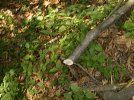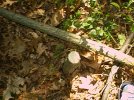Folks:
Despite Mr. Clifton's nefarious plot to corner the M-43 market, I've managed to acquire two of these guys over the past few months. Here's what happened when they got loose.
The Perpetrators
Edit - The Forum won't let me post a pic in two places, so here's a link to the infamous "Ignore" thread. The M-43s are at the top.
http://www.bladeforums.com/forums/showthread.php?s=&threadid=206485
Kesar M-43
OAL: 17 17/32"
Blade Length (from front of bolster): 12 15/16"
Blade Width (@ cho): 1 1/4"
Blade Width (@ sweet spot): 2 5/16"
Blade Thickness (@ cho): 1/4"
Blade Thickness (@ bend): 1/4"
Blade Thickness (@ forward grindline) 3/16"
POB: Approx. 3 15/16" from front of bolster
Max. Handle Diameter: 1 1/8"
Wt.: 27.5 oz.
Murali M-43
OAL: 18 1/4"
Blade Length (from front of bolster): 13"
Blade Width (@ cho): 1 1/4"
Blade Width (@ sweet spot): 2 3/32"
Blade Thickness (@ cho): 10/32"
Blade Thickness (@ bend): 11/32"
Blade Thickness (@ forward grindline) 1/4"
POB: Approx. 3 5/8" from front of bolster
Max. Handle Diameter: 1 1/4"
Wt.: 26 oz.
Here they are. The first acquisition was the Kesar (bottom khuk in pic). It is definitely different from any other khuk that I've handled. The pistol grip and broad belly make it very weight-forward. But, the handle is a little short and it doesn't move like I'd prefer.
To be blunt, I didn't really like it. At first, I thought that Mr. Clifton was welcome to all the M-43s that he could stuff into the Cave. I figured they'd make great kagas katnes. But, rather than write-off the much-hyped M-43 design, I decided to try another when the opportunity arose. So, along came the Murali.
The Murali is a separate beast, as you can see from the pic. The old two-smith's-interpretation bit, I guess. Unlike the Kesar, the Murali's handle is straight. It's blade-mass is distributed very differently than the Kesar khuk. The Murali is longer and leaner with a much more neutral feel. Also,it's fit and finish are more crude than the Kesar's, but that doesn't bother me.
I did a little work with the Murali when it arrived, and, while it performed very well, I still wasn't convinced. So, I decided to see what the two could do if given a real chance. The one that I liked the best, even if it was only relative, would be kept. The other would be sold.
The Crime Scene
Since I didn't want to make my building manager nervous by swinging steel on the side lawn, I set out to my folks' place in the 'burbs. There, the blades preceded to assault a series of victims, starting with...
Victim 1: 1 1/2" hardwood dowel
This provided the chance for both blades to face a uniform target. Both the Kesar and the Murali cut through in 4 strokes.
Victim 2: 2" cherry tree
In situ chopping was next on the list. My dad was interested by this point, so we proceded to the woods behind their property. The first unfortunate we encountered was a 2" cherry tree. The Kesar went to work.
Smack! Smack! Smack! The sweet spot seemed to guide itself to the target with each swing. The blade bit deeply, but did not bind. 7 blows later, and the poor cherry was down.
Victim 3: 2 1/2" cherry tree
This one was dead, but the bottom was solid. The Murali took this one out. The blade did not bight as deeply as the Kesar, and I had to make a conscious effort to apply the sweet spot. Still, it did not bind, and it moved faster than the Kesar. 12 strokes, and this cherry was ready to be made into kindling.
Victim 4: 3" hickory
The Kesar took this one on. 12 hits and down. Again, this khuk seemed to have eyes of its own. Either that, or it's all sweet spot.
Victim 5: ?
This one was covered in creepers, and I couldn't see the leaves clearly. My dad, who's fairly woodcrafty and good at id-ing trees and wood, called it a "jack" tree. Personally, I think that meant he didn't know jack about it.
This took 81 hits with the Murali before falling. Still, it took less than 4 minutes to accomplish and cost me no fatigue. However, the Murali twisted in my hand on two shots. I think that was due to the size and configuration of the handle. It has a couple of uneven spots which work against a good hold.
Victim 6: plastic jug
The final test was against a water-filled detergent jug. Since this was one of those impact-resistant polymer deals, I didn't expect much from either blade.
The Murali sent the jug flying. When I retrieved it, there was a 1" long cut on both sides of the jug, but only a dent in the middle, where the sweet spot struck.
The Kesar did the same, but made longer cuts on the front and back of the jug. I've never cut plastic bottles before, so this may not be unusual, but I was a little puzzled.
After having a couple of days to think about it, I have to admit that Jim is right. The M-43 is a great design (particularly the Kesar rendition). It's not one I'd choose for MA work, but it makes a top-notch utility blade in my hands.
Which one am I keeping? BOTH! (Sorry, Semp.) With work, I think I can get the Murali's handle where it needs to be. I like the heavy-duty nature of Murali's rendition (thick buttcap, heavy pins holding the handle together, thick blade). But, the Kesar and Murali are so different that I don't know that I'd call both of them M-43s.
S.
Edit - !@#$, photos didn't post. I'll try them separately.
Despite Mr. Clifton's nefarious plot to corner the M-43 market, I've managed to acquire two of these guys over the past few months. Here's what happened when they got loose.
The Perpetrators
Edit - The Forum won't let me post a pic in two places, so here's a link to the infamous "Ignore" thread. The M-43s are at the top.
http://www.bladeforums.com/forums/showthread.php?s=&threadid=206485
Kesar M-43
OAL: 17 17/32"
Blade Length (from front of bolster): 12 15/16"
Blade Width (@ cho): 1 1/4"
Blade Width (@ sweet spot): 2 5/16"
Blade Thickness (@ cho): 1/4"
Blade Thickness (@ bend): 1/4"
Blade Thickness (@ forward grindline) 3/16"
POB: Approx. 3 15/16" from front of bolster
Max. Handle Diameter: 1 1/8"
Wt.: 27.5 oz.
Murali M-43
OAL: 18 1/4"
Blade Length (from front of bolster): 13"
Blade Width (@ cho): 1 1/4"
Blade Width (@ sweet spot): 2 3/32"
Blade Thickness (@ cho): 10/32"
Blade Thickness (@ bend): 11/32"
Blade Thickness (@ forward grindline) 1/4"
POB: Approx. 3 5/8" from front of bolster
Max. Handle Diameter: 1 1/4"
Wt.: 26 oz.
Here they are. The first acquisition was the Kesar (bottom khuk in pic). It is definitely different from any other khuk that I've handled. The pistol grip and broad belly make it very weight-forward. But, the handle is a little short and it doesn't move like I'd prefer.
To be blunt, I didn't really like it. At first, I thought that Mr. Clifton was welcome to all the M-43s that he could stuff into the Cave. I figured they'd make great kagas katnes. But, rather than write-off the much-hyped M-43 design, I decided to try another when the opportunity arose. So, along came the Murali.
The Murali is a separate beast, as you can see from the pic. The old two-smith's-interpretation bit, I guess. Unlike the Kesar, the Murali's handle is straight. It's blade-mass is distributed very differently than the Kesar khuk. The Murali is longer and leaner with a much more neutral feel. Also,it's fit and finish are more crude than the Kesar's, but that doesn't bother me.
I did a little work with the Murali when it arrived, and, while it performed very well, I still wasn't convinced. So, I decided to see what the two could do if given a real chance. The one that I liked the best, even if it was only relative, would be kept. The other would be sold.
The Crime Scene
Since I didn't want to make my building manager nervous by swinging steel on the side lawn, I set out to my folks' place in the 'burbs. There, the blades preceded to assault a series of victims, starting with...
Victim 1: 1 1/2" hardwood dowel
This provided the chance for both blades to face a uniform target. Both the Kesar and the Murali cut through in 4 strokes.
Victim 2: 2" cherry tree
In situ chopping was next on the list. My dad was interested by this point, so we proceded to the woods behind their property. The first unfortunate we encountered was a 2" cherry tree. The Kesar went to work.
Smack! Smack! Smack! The sweet spot seemed to guide itself to the target with each swing. The blade bit deeply, but did not bind. 7 blows later, and the poor cherry was down.
Victim 3: 2 1/2" cherry tree
This one was dead, but the bottom was solid. The Murali took this one out. The blade did not bight as deeply as the Kesar, and I had to make a conscious effort to apply the sweet spot. Still, it did not bind, and it moved faster than the Kesar. 12 strokes, and this cherry was ready to be made into kindling.
Victim 4: 3" hickory
The Kesar took this one on. 12 hits and down. Again, this khuk seemed to have eyes of its own. Either that, or it's all sweet spot.
Victim 5: ?
This one was covered in creepers, and I couldn't see the leaves clearly. My dad, who's fairly woodcrafty and good at id-ing trees and wood, called it a "jack" tree. Personally, I think that meant he didn't know jack about it.
This took 81 hits with the Murali before falling. Still, it took less than 4 minutes to accomplish and cost me no fatigue. However, the Murali twisted in my hand on two shots. I think that was due to the size and configuration of the handle. It has a couple of uneven spots which work against a good hold.
Victim 6: plastic jug
The final test was against a water-filled detergent jug. Since this was one of those impact-resistant polymer deals, I didn't expect much from either blade.
The Murali sent the jug flying. When I retrieved it, there was a 1" long cut on both sides of the jug, but only a dent in the middle, where the sweet spot struck.
The Kesar did the same, but made longer cuts on the front and back of the jug. I've never cut plastic bottles before, so this may not be unusual, but I was a little puzzled.
After having a couple of days to think about it, I have to admit that Jim is right. The M-43 is a great design (particularly the Kesar rendition). It's not one I'd choose for MA work, but it makes a top-notch utility blade in my hands.
Which one am I keeping? BOTH! (Sorry, Semp.) With work, I think I can get the Murali's handle where it needs to be. I like the heavy-duty nature of Murali's rendition (thick buttcap, heavy pins holding the handle together, thick blade). But, the Kesar and Murali are so different that I don't know that I'd call both of them M-43s.
S.
Edit - !@#$, photos didn't post. I'll try them separately.




